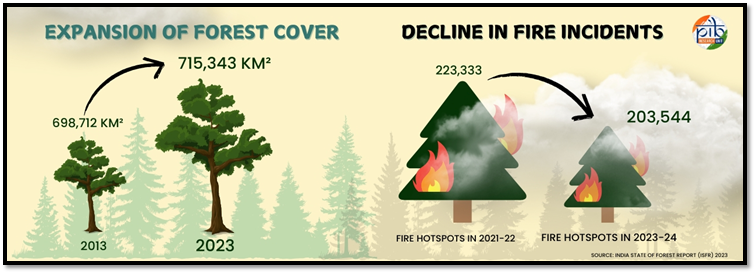INDIAN STATE FOREST REPORT (ISFR)

- The Indian State of Forest Report (ISFR) is a biennial publication by the Forest Survey of India (FSI) under the Ministry of Environment, Forest, and Climate Change (MoEFCC).
- It provides a comprehensive assessment of the forest and tree cover in India, serving as an essential tool for policymakers, environmentalists, and researchers
- Forests are crucial in mitigating climate change by sequestering carbon, supporting biodiversity, and ensuring access to clean air and water.
- Despite mounting environmental challenges, these ecosystems remain vital. In India, encouraging progress has been observed.
- According to the India State of Forest Report (ISFR) 2023, the country's combined Forest and Tree cover extends across 827,357 square kilometers, accounting for 25.17% of the total land area.
- This comprises 715,343 square kilometers (21.76%) of forest cover and 112,014 square kilometers (3.41%) of tree cover. These figures highlight India’s effective efforts to harmonize development with environmental preservation
- The India State of Forest Report (ISFR) 2023, released by the Forest Survey of India (FSI), provides a biennial evaluation of the nation's forest resources through satellite imagery and field surveys.
- Since its inception in 1987, this is the 18th edition of the report. The ISFR 2023 reveals notable growth in India’s forest cover, which has expanded from 698,712 km² in 2013 to 715,343 km² in 2023.
- Additionally, fire incidents have shown a decline, with 203,544 fire hotspots reported in 2023-24 compared to 223,333 in 2021-22. Aligning with India's Nationally Determined Contributions (NDCs), the nation has achieved a carbon sink of 30.43 billion tonnes of CO2 equivalent, adding 2.29 billion tonnes since 2005.
- This progress brings India closer to its goal of an additional 2.5–3.0 billion tonnes of CO2 equivalent by 2030. These advancements underscore India's commitment to sustainable environmental conservation
The Forest Survey of India (FSI) has played a crucial role in enhancing forest monitoring through initiatives such as improved forest cover mapping, the establishment of an upgraded Forest Fire Alert System, and the successful completion of the National Forest Inventory's first five-year cycle, which has yielded vital data on forest growth and carbon stocks. Additionally, digitizing forest boundaries in 25 States and Union Territories has significantly enhanced the accuracy of forest cover assessments. These advancements, along with efforts by the Ministry of Environment, Forest and Climate Change to expand forest and tree cover and conserve mangroves and wetlands, have greatly bolstered forest development.
Key schemes supporting these initiatives include:
- National Mission for a Green India (GIM): Launched in 2014, this mission focuses on protecting, restoring, and expanding forest cover through Joint Forest Management Committees (JFMCs). Rs. 944.48 crore has been allocated to 17 States and one Union Territory for plantation and eco-restoration projects.
- Nagar Van Yojana (NVY): Introduced in 2020, this program promotes green spaces in urban and peri-urban areas, with 546 projects approved across 31 States/UTs and a budget allocation of Rs. 431.77 crore.
- School Nursery Yojana (SNY): This initiative raises awareness about tree planting in schools. With Rs. 4.80 crore allocated, 743 projects have been sanctioned in 19 States/UTs.
- Mangrove Initiative for Shoreline Habitats & Tangible Incomes (MISHTI): Running from 2023 to 2028, this program aims to restore mangroves along India’s coastline, with Rs. 17.96 crore allocated to states like Andhra Pradesh, Gujarat, Kerala, Odisha, West Bengal, and Puducherry.
- National Coastal Mission: This program includes funding under the "Conservation and Management of Mangroves and Coral Reefs" component to safeguard coastal ecosystems in 9 coastal states and one Union Territory.
- National Plan for Conservation of Aquatic Ecosystems (NPCA): A collaborative initiative between the Central and State Governments for wetland conservation and management.
- Ek Ped Maa Ke Naam: Launched by the Prime Minister in June 2024, this campaign encourages tree planting in honor of mothers, fostering a cultural connection to nature.
- Compensatory Afforestation Fund Management and Planning Authority (CAMPA): This scheme mitigates forest cover loss caused by land diversion for non-forestry purposes under the Forest Conservation Act, 1980.
- Afforestation Targets under the Twenty-Point Programme: Annual afforestation targets are set using resources from Central and State Government schemes, NGOs, private organizations, and civil society.
- Awareness Campaigns and Plantation Drives: Events like Van Mahotsav, World Environment Day, and International Day of Forests encourage mass participation in tree planting and environmental awareness.
- Indian Forest Management Standard: Part of the National Working Plan Code – 2023, this standard provides a framework for monitoring sustainable forest management and supports the Indian Forest and Wood Certification Scheme for small-scale timber producers.
- National Action Plan on Forest Fire-2018: Offers preventive measures, resilience building, and community capacity enhancement for managing forest fires.
- Joint Forest Management and Eco Development Committees: In line with the 1988 National Forest Policy, these committees engage communities in forest and wildlife conservation, ensuring local involvement in sustainable management practices
|
Legal Framework to protect Wildlife
India's forest and wildlife resources are safeguarded and managed under a robust legal framework that promotes conservation and sustainable use. Prominent laws include the Indian Forest Act, 1927; the Forest Conservation Act, 1980; and the Wildlife Protection Act, 1972. These laws aim to protect wildlife and their habitats through measures like establishing national parks and wildlife sanctuaries. Additionally, State Forest Acts address region-specific forest management, while Tree Preservation Acts and Rules focus on safeguarding trees in both urban and rural settings. The implementation and enforcement of these legal provisions are primarily the responsibility of State Governments and Union Territories, ensuring the effective protection and management of forests and wildlife
|
|
For Prelims: Forest Survey of India (FSI), Indian State of Forest Report (ISFR)
For Mains: GS Paper III - Environment and Conservation, Climate Change
|




